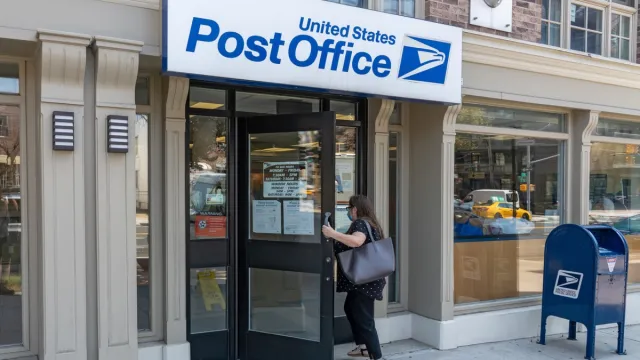The USPS Just Issued This Major Warning to Customers
The Postal Service is urging you to avoid falling for this scam.

The U.S. Postal Service (USPS) sent 129.2 billion pieces of mail in 2020 alone, according to the latest data from the agency. But even though sending and receiving mail seems pretty straightforward, countless people fall victim to USPS scams every year, from phishing emails to check fraud. Now, the Postal Service has issued a new warning to customers about one scam that could result in their mail never showing up at its intended destination. Read on for the agency's latest alert.
RELATED: If You Get This Message From the USPS, Don't Open It.
The USPS says that counterfeit stamps are being sold online.

Since the latter half of 2021, various Facebook posts and eBay listings have been advertising discontinued USPS stamps. The most recent example: a "bargain" roll of postage stamps being advertised on social media, claiming that people can can buy $58 worth of postage for only $39, according to The Washington Times. But the USPS is warning customers that these discontinued stamps are most likely fake.
"The Postal Service does not sell stamps below the value listed on the stamp," a spokesman for the U.S. Postal Inspection Service (USPIS), the agency's law enforcement arm, explained to The Washington Times in a Jan. 24 statement.
The fake stamp problem has only become more common.

Postal inspectors said they are "aware of an increase in suspected counterfeit stamps offered for sale with many being offered on online platforms and websites," per The Washington Times. According to the newspaper, social media and email advertisements for "discount postage" surged in December but have continued into the new year. Various ads and websites are offering a variety of postage, all at supposedly discounted costs.
"The number of counterfeit stamps being sold from online platforms has escalated. Scammers peddle fake stamps on social media marketplaces, e-commerce sites via third party vendors, and other websites," the USPIS warns on its website. "Counterfeit stamps are often sold in bulk quantities at a significant discount—anywhere from 20 to 50 percent of their face value. That's a tell-tale sign they're bogus."
RELATED: For more up-to-date information, sign up for our daily newsletter.
If you use a counterfeit stamp, your mail could be confiscated.

While it a good deal might seem worth the risk, if you want your mail to actually be delivered, don't take any chances. Andrea Avery, an assistant inspector in charge at the USPIS, told AARP that if a postal employee detects a counterfeit stamp, your mail will be confiscated and then reported to the USPIS.
"To ensure your trusted communication arrives at its destination without delay, the Postal Inspection Service wants you to be aware of—and avoid—phony postage," the USPIS warns. According to the law enforcement arm, the most "frequently encountered counterfeit stamp" is the Flag Stamp.
The USPIS recommends only buying stamps from approved vendors.

The USPIS warns on its website that "purchasing stamps from a third-party wholesaler or online websites can be unpredictable," as there is no way for a consumer to verify whether or not a stamp is real themselves. This is why the law enforcement service arm advises that people only buy postage from Approved Postal Providers.
"Approved vendors can include legitimate 'big box' or warehouse retailers who do provide very small discounts on postage stamps, but this is through resale agreements with the Postal Service," the USPIS explains.





















